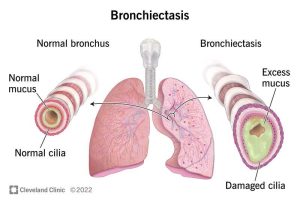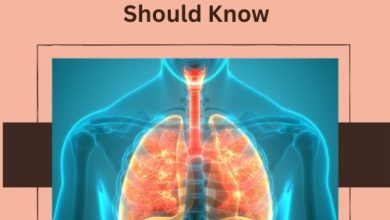Ayurvedic Treatment for Bronchiectasis: Natural Methods to Support Lung Health

Bronchiectasis is a chronic lung condition that causes permanent widening of the airways, leading to mucus build-up, persistent cough, shortness of breath, and recurring respiratory infections. While conventional treatments focus on symptom management and infection control, many people seek complementary approaches to improve their respiratory health. One traditional option that continues to draw interest is bronchiectasis treatment in Ayurveda.
Ayurveda, the ancient Indian system of medicine, emphasises natural remedies, diet, and lifestyle to promote balance in the body. If you’re looking for holistic ways to support lung function, particularly for a chronic condition like bronchiectasis, Ayurvedic treatment offers several possibilities worth exploring.
What Is Bronchiectasis?
Bronchiectasis causes the bronchial tubes in the lungs to become damaged and widened, making it difficult to clear mucus effectively. This leads to recurrent chest infections, inflammation, and in many cases, irreversible scarring.
Common symptoms include:
- Chronic productive cough
- Frequent chest infections
- Wheezing or breathlessness
- Fatigue
- Chest pain
The condition may be caused by infections like tuberculosis, autoimmune disorders, or underlying genetic issues such as cystic fibrosis. While antibiotics, airway clearance techniques, and inhalers form the cornerstone of standard care, many individuals with persistent symptoms are drawn to natural support systems like Ayurvedic treatment for bronchiectasis.

Related Article: Best Natural Treatment for Bronchiectasis: Practical Remedies That Work
Ayurvedic Understanding of Respiratory Disease
In Ayurveda, respiratory disorders are often linked to imbalances in the Kapha dosha and Vata dosha. Kapha governs mucus and lubrication, while Vata controls movement and flow. When Kapha accumulates in the lungs and blocks Vata, it can lead to stagnation, congestion, and inflammation — all typical features of bronchiectasis.
Ayurvedic physicians approach bronchiectasis as a Kasa-type disorder (chronic cough) or Shwasa (dyspnoea). The primary aim of treatment is to reduce mucus (Kapha), ease breathing, boost digestion (Agni), and strengthen overall immunity (Ojas).
Key Principles of Bronchiectasis Ayurvedic Treatment
1. Detoxification (Shodhana Therapy)
Panchakarma, the Ayurvedic system of detox, may be recommended to remove excess mucus and toxins. In particular, Herbal Treatment for Bronchiectasis like Vamana (therapeutic vomiting) and Nasya (nasal administration of medicated oils) help to clear the respiratory tract and support sinus and lung function.
Not all patients are suitable for full Panchakarma, especially if they’re weakened or during an infection flare-up. A skilled practitioner will assess the individual’s constitution and stage of illness before recommending detox protocols.
Related Article: Promising New Treatments for Bronchiectasis: What You Should Know
2. Herbal Remedies
Several herbs are traditionally used in bronchiectasis ayurvedic treatment to ease symptoms and support lung health:
- Vasaka (Adhatoda vasica): Known for its bronchodilator and expectorant properties. It helps thin mucus and ease coughing.
- Tulsi (Ocimum sanctum): A potent anti-inflammatory and antimicrobial herb used to support immune function.
- Pippali (Long pepper): Often combined with honey, it helps clear airways and supports digestion, which is crucial for Kapha reduction.
- Yashtimadhu (Licorice root): Soothes inflamed airways and supports tissue healing.
- Haridra (Turmeric): Rich in curcumin, it supports immune balance and helps reduce inflammation.
You may consider a customised herbal formulation from an Ayurvedic practitioner rather than self-medicating, as some herbs may not suit every constitution or medication regimen.
To learn more about herbs used in chronic respiratory conditions, see our related post on bronchiectasis ayurvedic treatment.
Diet for Lung Support
Ayurveda places strong emphasis on the role of diet in maintaining respiratory health. Since bronchiectasis is aggravated by excess Kapha, the diet should be light, warm, and easy to digest. Key dietary suggestions include:
- Avoid cold, heavy, oily, or dairy-rich foods, which increase mucus production.
- Include warming spices like ginger, turmeric, cumin, and black pepper.
- Sip warm water or herbal teas (e.g., tulsi, ginger, or liquorice tea) throughout the day.
- Eat freshly cooked meals; avoid processed and refrigerated foods.
A tailored Ayurvedic meal plan can also include stewed apples, cooked greens, and thin vegetable soups to aid digestion and reduce mucus build-up.
Related Article: Effective Bronchiectasis Treatments That Actually Help You Breathe Easier
Lifestyle Support for Lung Healthv
Daily habits play a significant role in Ayurvedic treatment. You can incorporate the following routines:
- Pranayama (breathing exercises): Techniques like Anulom Vilom and Bhastrika help expand lung capacity and improve oxygen exchange.
- Steam inhalation with medicinal herbs: Add tulsi or eucalyptus oil to boiling water for natural decongestion.
- Abhyanga (self-massage): Using warm sesame oil can help improve circulation and calm Vata.
- Adequate sleep and stress management: Rest is vital for tissue repair and immune support. Meditation and gentle yoga can reduce stress-induced inflammation.
If you’re considering integrating these steps, consult an experienced practitioner to ensure they align with your current treatment.
Comparing Ayurveda with Conventional Treatment
Conventional medicine for bronchiectasis primarily focuses on antibiotics, bronchodilators, and physiotherapy. These tools are essential for acute infections and maintaining lung function. However, they may not address the constitutional imbalances Ayurveda aims to correct.
That said, ayurvedic treatment for bronchiectasis is best used as a complementary approach, rather than a replacement. Many people combine both systems for a more comprehensive strategy—supporting lung health naturally while using conventional interventions as needed.
Related Article: Cystic Bronchiectasis Symptoms: What You Need to Know
Safety and Considerations
Before starting any Ayurvedic treatment, speak to your healthcare provider. Some herbs may interact with conventional medications, especially antibiotics, corticosteroids, or blood thinners.
Quality also matters. Always source herbs from reputable suppliers or seek personalised formulations from trained Ayurvedic doctors. Self-prescribing herbs without proper assessment may not offer benefits and, in some cases, may cause harm.
Remember that while Ayurveda offers valuable support, it does not claim to cure bronchiectasis. The goal is to enhance well-being, support lung function, and reduce symptom intensity over time.
Frequently Asked Questions
Q1: Can Ayurveda cure bronchiectasis?
No, Ayurveda does not offer a cure for bronchiectasis. However, it may help manage symptoms, improve immunity, and reduce mucus build-up when used consistently alongside medical treatment.
Q2: How long does Ayurvedic treatment take to show results?
This depends on the severity of the condition, individual constitution, and consistency with the treatment plan. Some notice improvements within weeks, while others may require several months.
Q3: Are there any side effects of herbal remedies?
Most Ayurvedic herbs are safe when used correctly. However, incorrect dosages or combinations can cause digestive issues, allergic reactions, or interact with medications. Consult a qualified practitioner before starting.
Q4: Is diet really that important?
Yes. In Ayurveda, diet is considered a cornerstone of healing. Avoiding mucus-producing foods and supporting digestion can significantly ease respiratory symptoms.
Related Article: Early Symptoms of Bronchiectasis: What You Should Watch Out For
Conclusion
If you’re managing bronchiectasis and looking for natural options to support your lung health, bronchiectasis treatment in Ayurveda offers several therapeutic tools. From herbs and dietary changes to detox therapies and breathing exercises, Ayurveda provides a holistic strategy aimed at improving quality of life.
Used responsibly and under guidance, Ayurvedic care may become a valuable ally in your broader health routine. For more detailed advice, explore our full guide to bronchiectasis ayurvedic treatment.




